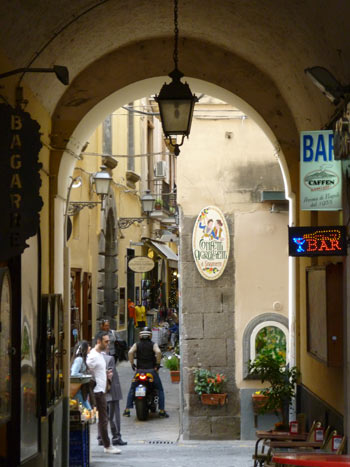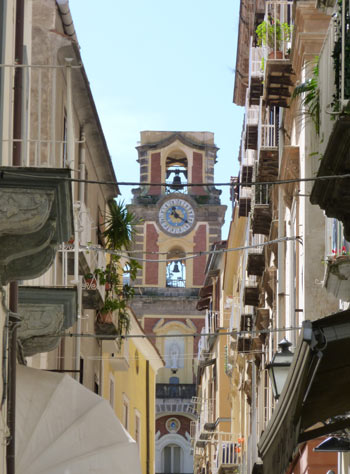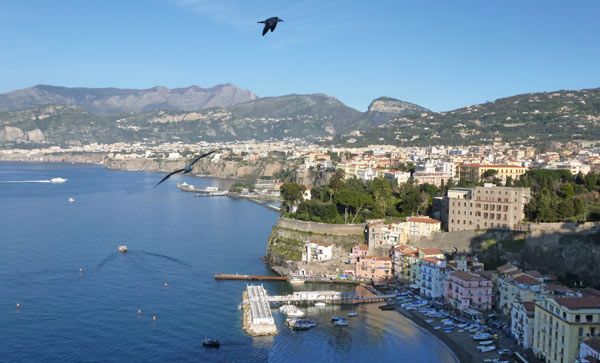Sorrento, perched picturesquely on a plateau above the sea with spectacular views over the Bay of Naples, has been a popular tourist destination for almost two centuries. Traditionally the town is one of the favourite resorts of British visitors to Italy, and over the last few decades it has ruled as Italy’s leading package-holiday destination for English-speakers. The historic seaside town has learned to live with, and make the most of tourism, and in return it offers a classic ‘Mediterranean summer holiday’ atmosphere – but without losing all of its Italian character and charm. The key attraction of Sorrento is that it can offer a variety of holiday experiences to suit different visitors, from rural walks through lemon and olive groves to a choice of excursions by land or sea. Pompeii, Herculaneum and Naples are accessible in one direction, and the Amalfi Coast in another. Days out can include Roman ruins, low-key seaside resorts, traditional villages and breathtaking scenery. Being well-connected and easy to get to makes this a straightforward and practical holiday choice.
> How to get to Sorrento
About Sorrento
Facing north over the Bay of Naples, Sorrento is situated towards the end of the mountainous Sorrentine peninsula, over the hills from the famous resorts of the Amalfi Coast. In mythology, this area is often identified as the land of the sirens, beautiful maidens of the sea whose song lured mariners to their doom. Sorrento is built on a historic site settled from prehistoric times onwards; there was a Greek town here, and then the Roman town of Sorrentum. A few relics of these times can be seen in the town museum. This was an obvious site to build a settlement; surrounded by low cliffs on one side and ravines on the other, it had a natural ring of defences, as well as access by sea and a fertile hinterland. Nowadays parts of the ravine are filled in – a bridge and town gate were demolished to make way for the modern town’s heart, Piazza Tasso. But even without these physical defences, Sorrento has managed to keep its historic town centre reasonably intact. Although many properties are now converted to tourist businesses, the mellow old buildings still help create the delightful authentic atmosphere which gives Sorrento a big advantage over modern beach resorts.

Sorrento and its sister towns, Sant’Agnello, Piano di Sorrento and Meta di Sorrento now spread all the way along the large plateau that was once primarily agricultural. The towns are all separated from the sea by low cliffs, and there are hardly any beaches – one of the most important things to realise for travellers planning a summer holiday. Sea access is mostly from wooden boardwalks built out over the water, although there are a few scraps of sandy beach along the coast, and enterprising visitors can find attractive coves and pebble beaches around the peninsula.
Sorrento is a pleasant town for pottering around; its pedestrian lanes, little tourist boutiques, limoncello tastings and restaurants all make it an easy and enjoyable place to dawdle and enjoy the holiday atmosphere. Tourists line the railings in the Villa Comunale park to enjoy grand views towards Vesuvius, Naples and Ischia and watch fiery sunsets behind the headland. Most visitors will catch a ferry for a day trip to Capri, or take a bus or boat to Positano or Amalfi. The more curious visitors will find their way down to old fishing quarter, Marina Grande, where you can eat seafood next to the harbour or take a boat trip with fishermen. There is a good range of things to do and sights to see – a few places of interest in Sorrento itself including the old town walls and a couple of museums, and more attractions a bus, train or boat ride away. Walkers will find a network of old mule paths and lanes across the peninsula which give the chance of enjoying the landscape close up.

Sorrento is just about unique in Italy for being both a highly-developed package-holiday-type resort as well as a historic town. Unlike other Italian seaside resorts, Sorrento caters overwhelming for the English-speaking market (though of course other foreigners and a few Italians do visit, too). Menus are in English, businesses are geared towards English-speaking travellers, and the throngs of cheap-and-cheerful British tourists do give Sorrento a somewhat less cultural and more blandly ‘summer holiday’ vibe. It is probably true that some visitors don’t care especially whether they are in Italy or Spain or Greece. However, there is more to Sorrento than this, if you care to look for it. Visiting out of the peak July-August period helps if you want a little peace and more atmosphere. And of course, the tourism success of Sorrento offers advantages: hundreds of hotels means a good choice of rooms and prices, especially out of season; the tourist and travel infrastructure is better than some other places; the levels of service and types of business are more satisfactory to international travellers; and English is almost universally spoken.
I visited Sorrento once, briefly, and thought it was a tourist trap overwhelmed by Brits. Years later I visited again, and thought the same for the first few hours. Then I relaxed, explored, got to know the town and visited some of the countryside and villages around. There’s no denying Sorrento is touristy. But I’d recommend it as a reassuring resort for Italy first-timers, a well-serviced destination for an easy holiday in the sun, and a practical base for visiting the sights in the area. You can enjoy different types of holiday here depending on what you’re looking for, where you stay and what you decide to do, from an elegant five-star honeymoon sipping cocktails on a panoramic terrace to a family vacation in a hotel with a swimming pool. It’s an amiable good-tempered town and retains an impressive amount of ‘Italian-ness’ for such a visited place.
Reading and preparation
Sorrento has its own bookshop with two branches where you can buy a good selection of English-language and local interest books, though it would be a good idea to buy a guide in advance to help with your activity planning. Sorrento is fairly small and you don’t necessarily need a guidebook for the town itself, but if you’re planning trips further afield you might find a general guide to the region handy – for example the Rough Guide to Naples and the Amalfi Coast. I found the locally-published Sorrento: Visiting Paradise – A Literary Guidebook
was a fascinating read to dip into, full of anecdotes from Sorrento’s early visitors providing vivid impressions of local life and tourism in the nineteenth and early twentieth centuries. The best way to really get to know the landscape of the Sorrento peninsula and the Amalfi Coast is on foot and Sorrento, Amalfi Coast and Capri: Car Tours and Walks (Landscapes)
is probably the best specialist guidebook you’ll find for the area. Especially good for walkers, it includes recommended walks (and strolls) in the Sorrento and Amalfi Coast areas, including practical information about public transport.
> Sorrento hotels, B&Bs and apartments – check what’s available
On this site
Useful links
